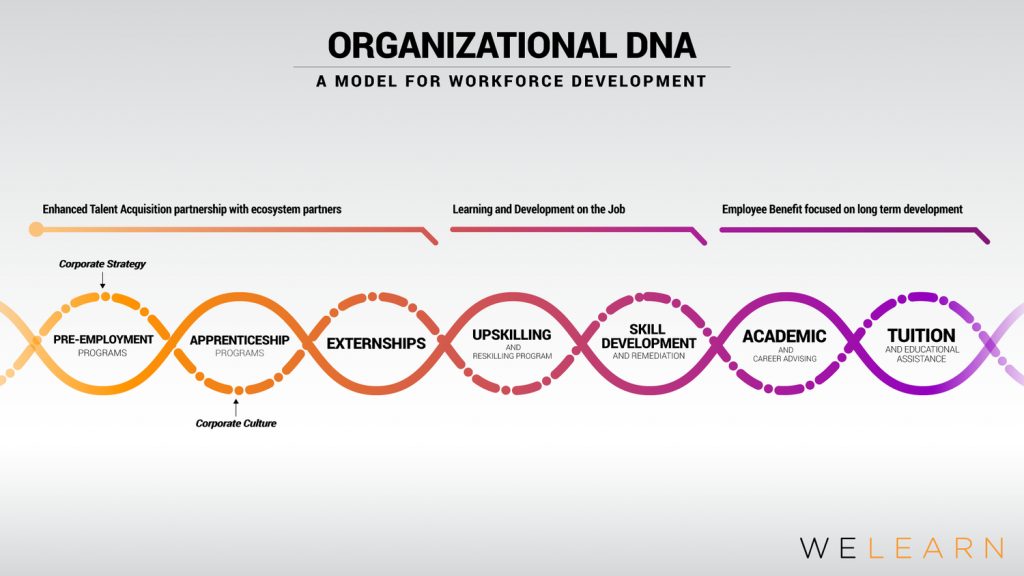Can We Talk About Talent?
Odds are as a talent development leader you are faced with the same challenges many as other talent development leaders– how do I find, develop, retain, and grow the talent that I need in my organization. This rings even truer if your organization is looking to recruit middle skills talent – that talent that has a high school diploma – but requires less training than a four-year degree.
Consider this:
- 69% of HR executives say their inability to attract and retain middle skills talent frequently affects their firm’s performance.
- More than 50% of companies report it is increasingly hard to find workers to fill middle skills jobs.
We certainly agree that part of the issue here is a skills gap – we believe that the skills gap is not insurmountable – and is only one part of the issue. The bigger issue is how organizations approach workforce development – and how engrained workforce development is in the organizations DNA.
Based on our experience in working with middle skills workers and the organizations that hire them, we see the disconnect clearly – and it begins with not having a cohesive, articulated strategy for workforce development. We believe that there is an Organizational DNA Model for Workforce Development.
The Organizational DNA model is comprised of five components:
- Corporate Strategy
- Corporate Culture
- Enhanced Talent Acquisition
- Learning and Development
- Learning as an Employee Benefit
As most of us would agree to bring a new approach to learning or talent development requires an alignment of corporate strategy and corporate culture to ensure that the new approach will be successful, so for the sake of our discussion here, let’s assume that your organizational strategy is focused on tapping into new sources of talent and that your culture is one in which lifelong learning is valued.
Enhanced Talent Acquisition
FRONTLINE AND MIDDLE-SKILLS WORKERS DO NOT LIVE WHERE YOU ARE LOOKING.
What does that mean? – it means they are not on LinkedIn, your job board of choice, and may not even be looking for the jobs you are looking to fill.
Organizational DNA requires that organizations widen then lens of their talent acquisition strategy. This starts with examining job descriptions for all job roles and ensuring that job descriptions are targeted to the right level of education for the specific roles. For example, should being a clinical medical assistant or an entry-level IT professional require a 2 or four-year degree or could someone take on that role with a high school diploma/GED and a credential.
Beyond the role description, an enhanced talent acquisition talent strategy means moving beyond job postings. Organizations should think about pre-hire training programs, externship programs, or apprenticeship programs. It’s all about figuring out how to communicate with your target audience e.g. middle-skill workers where they naturally look to find information!
Learning & Development
Learning and Development is a key strategy for building talent inside of organizations. Ensuring that your L&D function provides opportunities to reskill workers and upskill workers inside the organization can build your internal talent pipeline. For example, a cafeteria worker or a custodial worker hired into a healthcare organization could be your next Certified Nursing Assistant or medical billing and coding professional. L&D functions should ensure that programs and offerings are aligned to career pathways and promote the building of future talent.
Learning As An Employee Benefit
Over 80% of organizations have an educational assistance or tuition assistance programs, however, most of these programs and policies are underutilized and do not promote strategic development of employees to advance in the organization.
Organizations that have workforce development in their DNA craft these policies to be accessible to all parts of their workforce and increasingly forward-thinking companies are embedding offerings such as academic advising and educational prepayment in order to remove barriers to entry for their frontline workers.
By focusing on these three areas, not only are organizations embedding workforce development in their DNA, but they are also communicating education and learning is a cornerstone of their employee value proposition
In our next post, we will explore what benefits an Organizational DNA approach to workforce development delivers for organizations.

